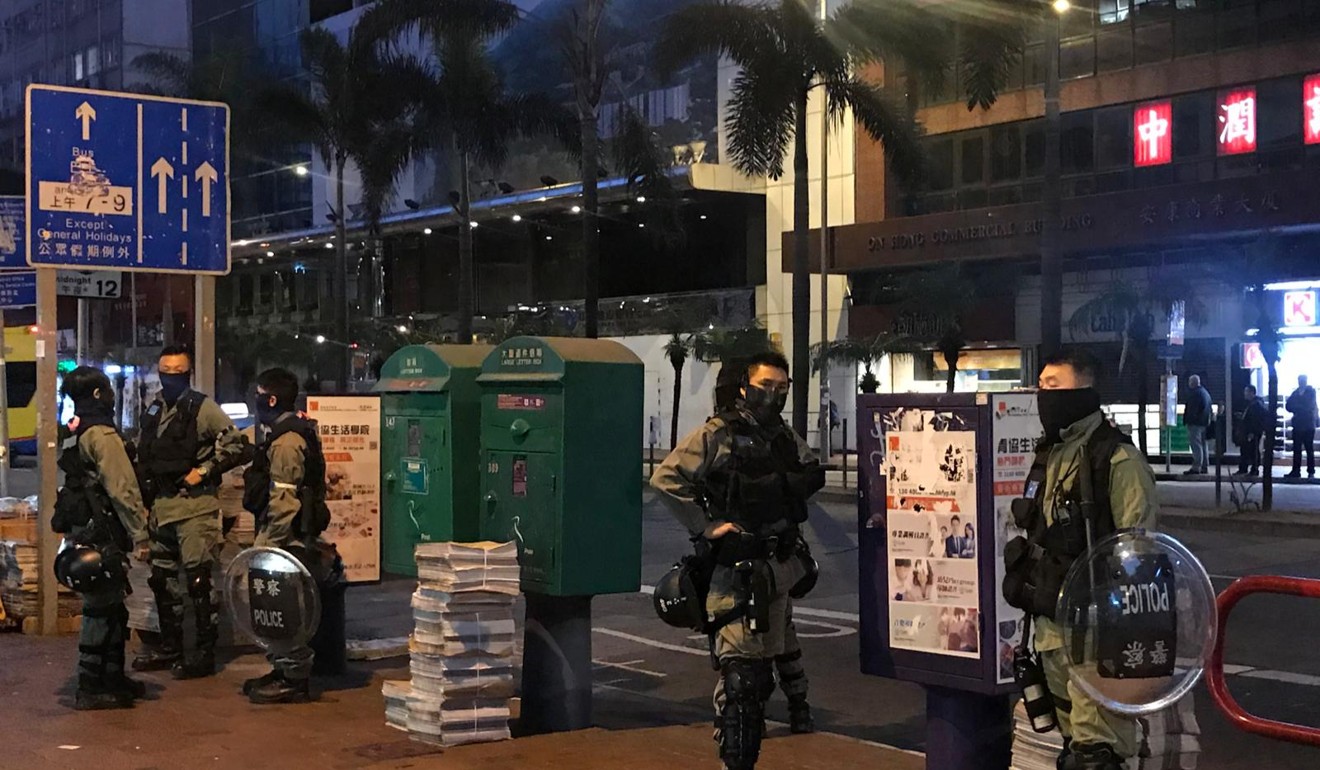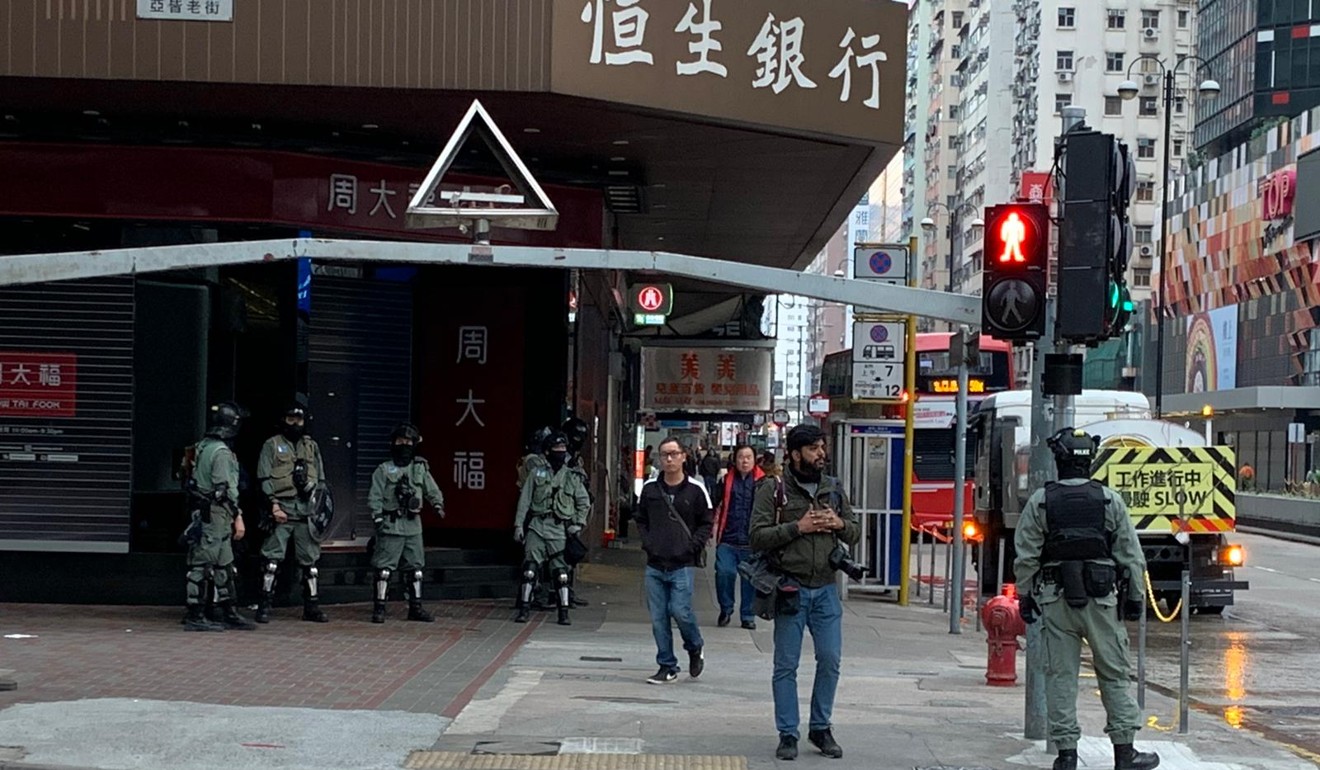
Hong Kong protests: only a few dozen people show up at lunchtime demonstrations as citywide strike turns out to be non-event
- Demonstrators had threatened to paralyse the city on Monday morning
- But only a few dozen protesters show up at lunchtime in Sha Tin, Cheung Sha Wan, and Tuen Mun
Protesters mostly stayed at home on Monday, ignoring calls for a citywide strike as Hong Kong marked the six-month anniversary of anti-government unrest.
There was no disruption on the city’s roads, and only three minor incidents on the rail network, with just one causing a temporary suspension of services.
Around noon, a few dozen protesters showed up at lunchtime protests in three districts – Sha Tin, Cheung Sha Wan, and Tuen Mun. A crowd of less than 10 people tried to block a road in Mong Kok, but there was no protest in Central.
A day after organisers estimated that 800,000 people took to the streets for a largely peaceful rally, only a handful returned on Monday morning, and commuters were able to head to work as normal.
There were reports of three incidents involving objects thrown on to railway lines between 5am and 7am, and a rubbish bin thrown on to tracks near Sha Tin MTR station caused services to be briefly suspended.

The other two incidents happened in the New Territories, at Fanling and Tuen Mun stations, but these were cleared before services began.
Near Sheung Tak Estate, in Tseung Kwan O, a small group of protesters tried to use furniture and a rubbish bin to block a road, but police quickly cleared the debris, and arrested at least one protester.
In Lam Tin, outside Kai Tin Shopping Centre, more than 10 masked protesters briefly blocked traffic on Kai Tin Road with flower pots, bricks and traffic cones at about 9.10am, but a few people quickly helped move the objects about five minutes later as riot police arrived.
At least one man was arrested after being chased after by officers.
In busier parts of the city, such as Mong Kok, Wan Chai and Causeway Bay, handfuls of protesters could be seen milling about, while some riot police were stationed nearby.
A group of about six men attempted to block Nathan Road in Mong Kok by placing rubbish in the road, but fled when riot police emerged.
At the junction of Argyle Street and Nathan Road, someone pressed the emergency button on a moving bus, forcing the driver to briefly pull over and temporarily suspended the service.

University student Gel, 20, was among the few appearing in Mong Kok at 6am with her classmate. She said the small turnout in the morning might be down to everyone’s exhaustion from the march on Sunday.
“800,000 people [according to the front’s estimation] marched yesterday six months after the movement started. And some of us stayed late in Mong Kok last night,” she said.

A Form Two student, surnamed Lau, said she had planned to block roads in Wan Chai, and had arrived at around 6am, only to find no protesters, but lots of riot police and reporters.
“I feel like many people have given up … we will lose if this continues and the government will win,” she said.
But she said she would boycott classes at school for the whole day with permission from her parents, her third time boycotting classes since schools started in September.
Between 1pm and 1.30pm, dozens of people started marches in Sha Tin, Tuen Mun, and Lai Chi Kok which went on for around an hour. The protesters chanted slogans such as “Five demands, not one less!” and “Fight for freedom. Stand with Hong Kong!” as riot police were on standby.
Police stopped and searched less than 10 black-clad youngsters outside Sha Tin Town Hall, while at least one woman was taken into custody. In Lai Chi Kok, riot police raised blue flag at the rally goers, warning them that they had taken part in an illegal assembly, and urging them to disperse quickly.
In Mong Kok, several black-clad protesters staged roadblocks in a flashmob protest near Langham Place at around 1pm.
Monday’s non-strike followed the approved march on Sunday, which organisers the Civil Human Rights Front estimated 800,000 people had taken part in across Hong Kong Island.
The march was largely peaceful until nightfall, when some radical protesters allegedly hurled petrol bombs at the entrance of the High Court and Court of Final Appeal.
Protesters announced online on Sunday night that they would paralyse traffic if the government did not respond to their five demands, including an independent inquiry into police use of force at protests.



